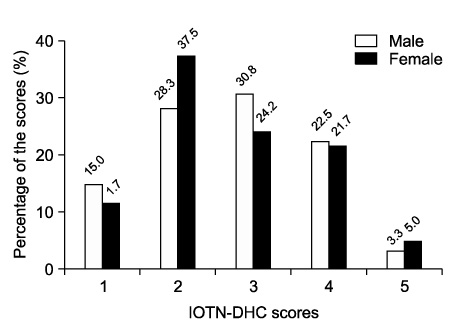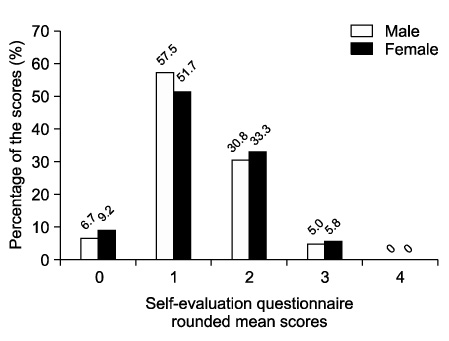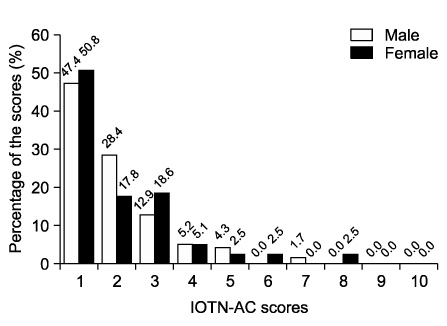Korean J Orthod.
2011 Dec;41(6):440-446. 10.4041/kjod.2011.41.6.440.
Associations between normative and self-perceived orthodontic treatment needs in young-adult dental patients
- Affiliations
-
- 1Orthodontic Research Center and Department of Orthodontics, Faculty of Dentistry, Shiraz University of Medical Sciences, Shiraz, Iran.
- 2Dentist in Private Practice, Shiraz, Iran.
- 3Department of Dental Morphology, Dental Branch, Islamic Azad University, Tehran, Iran. vahid.rakhshan@gmail.com
- KMID: 2273192
- DOI: http://doi.org/10.4041/kjod.2011.41.6.440
Abstract
OBJECTIVE
Our aim was to determine the correlation between dental treatment need as assessed by the components of the index of orthodontic treatment need (IOTN) and a self-evaluation questionnaire in a population selected from the dental clinics of Shiraz, Iran.
METHODS
The dental treatment needs of 240 participants (120 men and 120 women) were measured on the basis of the IOTN dental health component (IOTN-DHC), IOTN aesthetic component (IOTN-AC), IOTN AC determined by the examiner (IOTN-ACE), and a self-evaluation questionnaire (SEQ). The correlations between the treatment needs assessed by all the methods as well as the correlations of the treatment needs with age and gender were assessed using a Spearman's correlation coefficient (alpha = 0.01).
RESULTS
All methods were significantly correlated (p < or = 0.001). The associations of IOTN-ACE with IOTN-DHC and SEQ were moderately significant (rho = 0.49 and 0.41, respectively). The associations of IOTN-AC with IOTN-DHC and SEQ were weakly significant (rho = 0.24 and 0.35, respectively). The IOTN-DHC was moderately associated with SEQ (rho = 0.53). Gender and age were not associated with treatment needs estimated by any of the methods used (p > 0.06).
CONCLUSIONS
The correlations between the self-evaluation and the IOTN components in young adults were close to those reported in children, and IOTN-ACE was more reliable than IOTN-AC.
Keyword
MeSH Terms
Figure
Cited by 1 articles
-
Associations between body dysmorphic disorder (BDD) with the dental health component of the index of orthodontic treatment need (IOTN-DHC) and other BDD risk factors in orthodontic patients: A preliminary study
Farhad Sobouti, Foruzan Elyasi, Reza Alizadeh Navaei, Farbod Rayatnia, Nika Rezaei Kalantari, Sepideh Dadgar, Vahid Rakhshan
Korean J Orthod. 2023;53(1):3-15. doi: 10.4041/kjod22.155.
Reference
-
1. Tsakos G. Combining normative and psychosocial perceptions for assessing orthodontic treatment needs. J Dent Educ. 2008. 72:876–885.
Article2. Kerosuo H, Al Enezi S, Kerosuo E, Abdulkarim E. Association between normative and self-perceived orthodontic treatment need among Arab high school students. Am J Orthod Dentofacial Orthop. 2004. 125:373–378.
Article3. Shue-Te Yeh M, Koochek AR, Vlaskalic V, Boyd R, Richmond S. The relationship of 2 professional occlusal indexes with patients' perceptions of aesthetics, function, speech, and orthodontic treatment need. Am J Orthod Dentofacial Orthop. 2000. 118:421–428.
Article4. Chu CH, Choy BH, Lo EC. Occlusion and orthodontic treatment demand among Chinese young adults in Hong Kong. Oral Health Prev Dent. 2009. 7:83–91.5. Tang EL, So LL. Correlation of orthodontic treatment demand with treatment need assessed using two indices. Angle Orthod. 1995. 65:443–450.6. Nobile CG, Pavia M, Fortunato L, Angelillo IF. Prevalence and factors related to malocclusion and orthodontic treatment need in children and adolescents in Italy. Eur J Public Health. 2007. 17:637–641.
Article7. Sheats RD, McGorray SP, Keeling SD, Wheeler TT, King GJ. Occlusal traits and perception of orthodontic need in eighth grade students. Angle Orthod. 1998. 68:107–114.8. Birkeland K, Boe OE, Wisth PJ. Orthodontic concern among 11-year-old children and their parents compared with orthodontic treatment need assessed by index of orthodontic treatment need. Am J Orthod Dentofacial Orthop. 1996. 110:197–205.
Article9. Phillips C, Beal KN. Self-concept and the perception of facial appearance in children and adolescents seeking orthodontic treatment. Angle Orthod. 2009. 79:12–16.
Article10. Mugonzibwa EA, Kuijpers-Jagtman AM, van't Hof MA, Kikwilu EN. Comparison between the opinions of Tanzanian parents and their children on dental attractiveness. Angle Orthod. 2004. 74:63–70.11. Koochek AR, Yeh MS, Rolfe B, Richmond S. The relationship between Index of Complexity, Outcome and Need, and patients' perceptions of malocclusion: a study in general dental practice. Br Dent J. 2001. 191:325–329.
Article12. Onyeaso CO, Sanu OO. Perception of personal dental appearance in Nigerian adolescents. Am J Orthod Dentofacial Orthop. 2005. 127:700–706.
Article13. Svedström-Oristo AL, Pietilä T, Pietilä I, Vahlberg T, Alanen P, Varrela J. Acceptability of dental appearance in a group of Finnish 16- to 25-year-olds. Angle Orthod. 2009. 79:479–483.
Article14. Stenvik A, Espeland L, Mathisen A. A longitudinal study on subjective and objective orthodontic treatment need. Eur J Orthod. 1997. 19:85–92.
Article15. Bos A, Hoogstraten J, Prahl-Andersen B. Expectations of treatment and satisfaction with dentofacial appearance in orthodontic patients. Am J Orthod Dentofacial Orthop. 2003. 123:127–132.
Article16. Abu Alhaija ES, Al-Nimri KS, Al-Khateeb SN. Self-perception of malocclusion among north Jordanian school children. Eur J Orthod. 2005. 27:292–295.
Article17. Mandall NA, McCord JF, Blinkhorn AS, Worthington HV, O'Brien KD. Perceived aesthetic impact of malocclusion and oral self-perceptions in 14-15-year-old Asian and Caucasian children in greater Manchester. Eur J Orthod. 2000. 22:175–183.
Article18. Johansson AM, Follin ME. Evaluation of the aesthetic component of the Index of Orthodontic Treatment Need by Swedish orthodontists. Eur J Orthod. 2005. 27:160–166.
Article19. Chew MT, Aw AK. Appropriateness of orthodontic referrals: self-perceived and normative treatment needs of patients referred for orthodontic consultation. Community Dent Oral Epidemiol. 2002. 30:449–454.
Article20. Al-Sarheed M, Bedi R, Hunt NP. Orthodontic treatment need and self-perception of 11-16-year-old Saudi Arabian children with a sensory impairment attending special schools. J Orthod. 2003. 30:39–44.
Article21. Brook PH, Shaw WC. The development of an index of orthodontic treatment priority. Eur J Orthod. 1989. 11:309–320.
Article22. Richmond S, Shaw WC, Stephens CD, Webb WG, Roberts CT, Andrews M. Orthodontics in the general dental service of England and Wales: a critical assessment of standards. Br Dent J. 1993. 174:315–329.
Article23. Hedayati Z, Fattahi HR, Jahromi SB. The use of index of orthodontic treatment need in an Iranian population. J Indian Soc Pedod Prev Dent. 2007. 25:10–14.
Article24. Svedström-Oristo AL, Pietilä T, Pietilä I, Alanen P, Varrela J. Morphological, functional and aesthetic criteria of acceptable mature occlusion. Eur J Orthod. 2001. 23:373–381.25. Soh J, Sandham A. Orthodontic treatment need in Asian adult males. Angle Orthod. 2004. 74:769–773.
- Full Text Links
- Actions
-
Cited
- CITED
-
- Close
- Share
- Similar articles
-
- Comparing locus of control in orthodontic patients of a university dental hospital with those of a private dental clinic
- Relationship between locus of control and treatment compliance in adult orthodontic patients
- A study on changes in the form and dimensions of dental arches resulting from orthodontic treatment
- Prevalence and characteristics of impacted teeth in Korean orthodontic patients at ten university dental hospitals
- Evaluation of anxiety level changes during the first three months of orthodontic treatment





